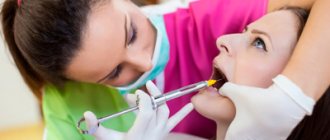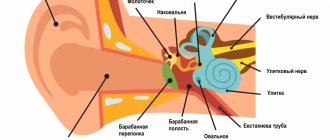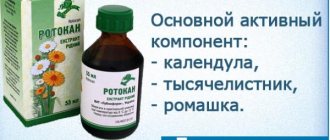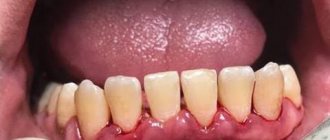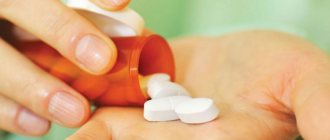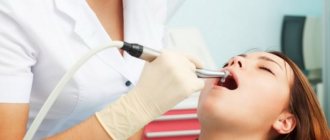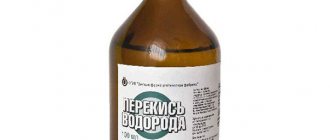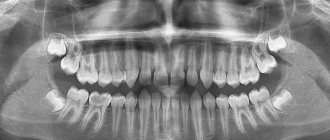General recommendations
Extirpation ends by placing a cotton swab on the operated area. If the bleeding is minor, it can be removed after a few minutes. In case of increased bleeding, it is allowed to keep the cotton wool for up to half an hour; if the process continues, the doctor uses hemostatic drugs. When the cotton wool is held for too long, the blood clot may stick to it and fall out, and the socket with the bone will lose its natural protection from the external environment.
How to stop bleeding after tooth extraction at home:
- apply a special hemostatic sponge (sold in a pharmacy);
- make a tight swab from sterile gauze, apply to the hole and bite;
- if the problem is caused by increased blood pressure, then you need to take appropriate medications;
- use ice or frozen foods pre-wrapped in a towel as a cooling compress.
Smoking after tooth extraction is unacceptable, since cigarettes contain nicotine, which constricts blood vessels. As a result of this action, the cells do not receive the required amount of oxygen and nutrients, so the regeneration processes slow down, the risk of infection increases, scarring and improper tissue fusion are possible.
On the day of surgery, you should not rinse your mouth, engage in sports or other physical activity; it is best to go home from the clinic and rest. Routine oral hygiene or rinsing is not recommended.
In nutrition, preference should be given to soft, liquid and warm foods.
After tooth extraction, you should not do the following.
- In the first couple of days, taking a hot bath is excluded, only a warm shower.
- During sleep, you need to be careful not to lie on the side where the tooth was removed, this provokes the appearance of swelling.
- Visiting the gym and active physical activity should be postponed in the first days.
- Do not touch the wound with your tongue or foreign object.
- Do not open your mouth very wide, do not use active chewing and facial movements to avoid the sutures coming apart.
- Aspirin is not suitable as an anesthetic due to the fact that it has a thinning effect on the blood and may cause bleeding and hematoma.
- Do not rinse during the first few days. This can negatively affect the loss of a blood clot from the socket and the occurrence of inflammation.
For more information and to make an appointment with a specialist, call:
+7,
What medications are needed?
Antibiotics after tooth extraction are prescribed by the surgeon who performed the extraction. You can replace medications from the list with cheaper analogues, the main thing is that they have a wide range of applications, since there are different microorganisms in the mouth. Amoxiclav is often prescribed because it is effective and has a minimum of contraindications and side effects. The drugs are taken in the course determined by the doctor.
Anesthesia after tooth extraction lasts for several hours, after which pain appears, which can be eliminated with the help of analgesics. Anti-inflammatory drugs, for example Nimesil, and vitamins to strengthen the immune system can also be prescribed.
How to rinse your mouth after tooth extraction:
- chlorhexidine;
- a weak solution of potassium permanganate;
- furatsilin;
- miramistin;
- similar antiseptics.
In addition to pharmaceutical products, rinsing can be done with soda, saline solutions, decoctions of chamomile, sage, oak bark, calendula, and eucalyptus. They not only protect against infection, but also relieve swelling and accelerate tissue healing.
Temperature after tooth extraction is one of the possible symptoms, as tissues are injured and foreign elements penetrate the body. To improve your health, you need to take antipyretics.
If your gums are inflamed
It is not always possible to avoid infection of the wound surface, especially when the patient neglects the advice of the dentist. In case of inflammation, you should consult a doctor for examination and identification of the causes of inflammatory reactions.
If the hole is not closed after tooth extraction, alveolitis develops. The natural plug can come off due to intensive rinsing, licking the wound with the tongue, resumption of bleeding and improper actions to stop it. Alveolitis is accompanied by acute pain syndrome. Not only the injured area may hurt, but also the throat, head, jaws, and neighboring teeth.
How long the gums heal after tooth extraction depends on various factors:
- complications of surgical intervention;
- the presence of inflammation or other complications;
- age criterion, the older the patient, the longer the healing and tissue restoration takes place;
- state of immunity, individual characteristics.
What and when to eat
During the rehabilitation period, food should be soft, mostly liquid, and have a comfortable temperature. How much you can’t eat after tooth extraction depends on whether there is heavy bleeding or not. If blood clotting is normal, then a protective clot is formed and securely attached within 2 to 3 hours. After this, the restriction is lifted. With complex extraction, the time can increase to 4.6 hours.
It is advisable to exclude spicy, sweet foods, carbonated drinks, alcohol, raw vegetables, fruits with a high acid content. Chewing is carried out on the opposite side of the jaw. It is better not to eat rough, hard food, as you may accidentally touch the wound.
Ibuprofen
When prescribing ibuprofen, it is necessary to take into account its interaction with the following drugs:
— Acetylsalicylic acid or other NSAIDs: increased risk of developing gastrointestinal ulcers and gastrointestinal bleeding. Ibuprofen can inhibit the anti-inflammatory and antiplatelet effects of acetylsalicylic acid in small doses when taken simultaneously.
- Glucocorticosteroids and mineralocorticosteroids: increased risk of developing ulcerative lesions of the gastrointestinal tract or developing gastrointestinal bleeding.
- Antihypertensive drugs and diuretics: NG1VP may reduce the effects of diuretics and antihypertensive drugs. In some patients with impaired renal function (eg, dehydrated patients or elderly patients with impaired renal function), concomitant use of angiotensin-converting enzyme inhibitors, beta blockers, and angiotensin II receptor inhibitors with drugs that inhibit cyclooxygenase may lead to a further deterioration of function. kidneys, including the possibility of developing acute renal failure, which is usually reversible. Therefore, this combination should be used with caution, especially in elderly patients. Patients should be adequately hydrated and renal function should be monitored after initiation of combination therapy and periodically thereafter.
- Potassium-sparing diuretics: simultaneous use of ibuprofen and potassium-sparing diuretics can lead to hyperkalemia (it is recommended to monitor potassium levels in the blood).
- Indirect coagulants, antiplatelet agents, fibrinolytics: NSAIDs may enhance the effects of indirect anticoagulants such as warfarin.
- Thrombolytics: when used simultaneously with thrombolytic drugs (alteplase, streptokinase, urokinase), the risk of bleeding increases.
- Selective serotonin reuptake inhibitors: increased risk of gastrointestinal bleeding.
- Lithium, digoxin, phenytoin: Combination therapy with ibuprofen and lithium, lithium digoxin, digoxin or phenytoin may increase serum concentrations of these drugs.
- Methotrexate: the use of ibuprofen at a dose of 200 mg within 24 hours before or after the use of methotrexate may lead to increased concentrations of methotrexate in the blood and an increase in its toxic effects.
- Baclofen: There are clinical data indicating that NSAIDs may increase plasma concentrations of baclofen.
- Zidovudine: There is evidence that the risk of hemarthrosis and hematomas is increased in HIV-infected patients with hemophilia receiving both zidovudine and ibuprofen.
—Quinolones: Animal data indicate that NSAIDs may increase the risk of seizures associated with quinolone use. Patients taking quinolones and ibuprofen concomitantly have an increased risk of developing seizures.
- Cyclosporine, tacrolimus, gold preparations: the risk of nephrotoxicity may increase due to a decrease in the synthesis of prostaglandins in the kidneys. Renal function should be carefully monitored during combination therapy, especially in elderly patients. Ibuprofen increases the plasma concentration of cyclosporine and the likelihood of developing its hepatotoxic effects.
- Mifepristone: Since NSAIDs may reduce the effectiveness of mifepristone, NSAIDs should be started no earlier than 8-12 days after stopping mifepristone.
- Drugs that block tubular secretion: may increase plasma concentrations of ibuprofen.
- Hypoglycemic drugs for oral administration, sulfonylurea derivatives: as a precautionary measure, it is recommended to monitor the concentration of glucose in the blood when used together.
- Sulfinpyrazone, probenecid: when used together with ibuprofen, the excretion of ibuprofen may be slowed down.
- Aminoglycosides: Ibuprofen may reduce the clearance of aminoglycosides, which may increase the nephrotoxicity and hepatotoxicity of these drugs.
- Cefamandole, cefaperazone, cefotetan, valproic acid, plicamycin: may increase the incidence of hypoprothrombinemia when co-administered with ibuprofen.
— Inducers of microsomal oxidation (phenytoin, barbiturates, rifampicin, phenylbutazone, tricyclic antidepressants): when used together, they increase the production of hydroxylated active metabolites, increasing the risk of severe intoxication.
— Uricosuric drugs: ibuprofen reduces the effectiveness of uricosuric drugs
- Estrogens, ethanol: with simultaneous use of ibuprofen, the side effects of estrogens and ethanol may increase.
Antacids and cholestyramine: drugs reduce the absorption of ibuprofen.
Caffeine: enhances the analgesic effect of ibuprofen.
Oral hygiene
It is not carried out on the first day to exclude infection and accidental injury. Chlorhexidine can be used almost immediately after tooth extraction, as it does not cause side effects; the main thing is to rinse carefully and according to the instructions. Further hygienic cleaning can be performed once a day with a soft brush, carefully avoiding the surgical area.
Floss is also used to remove food debris from between teeth and a warm saline solution is used to rinse the mouth after each meal. Do not forget about cleansing your tongue, as plaque also accumulates on it, in which bacteria actively multiply.
Removal of sutures after tooth extraction occurs on the 7th - 10th day. By this time, the wounds have already healed and restrictions on hygiene procedures are lifted. Cleaning is carried out twice: in the morning and in the evening.
First week after removal.
The first day after your tooth is removed, doctors advise you to refrain from rinsing. And in the following days, experts recommend not to overdo this procedure, but simply keep the medicine in your mouth for some time. Such baths should be done several times a day using various anti-inflammatory and disinfectants, including
- decoction of oak bark;
- decoction of chamomile or sage;
- miramistin;
- chlorhexidine;
- furacillin solution.
These drugs will help relieve inflammation, pain and swelling, and also have a deodorizing function. Speaking of oral hygiene, in the first days you should brush around the teeth that are located close to the affected area, and also under no circumstances use rinses or other liquids to clean the mouth.
Pathology and norm
With any invasive procedure, swelling occurs in the soft tissues. It goes away on its own within a few days. The same can be said about pain. Cheekbones, adjacent teeth, head, and neck may hurt. If after 3 or 4 days the symptoms do not disappear, but increase, then this indicates pathology.
What are the complications after tooth extraction:
- alveolitis, osteomyelitis, most often occurring with dry socket;
- inflammation near the seams;
- damage to the adjacent dental unit;
- perforation of the bottom of the maxillary sinus, if extraction is performed on the upper jaw;
- fracture of the alveolar process, sharp edges of the alveolus that injure soft tissues;
- neuritis of the inferior alveolar nerve;
- postoperative cyst;
- paresthesia, which is characterized by numbness, loss of sensitivity of the cheeks, tongue, jaw and other adjacent areas;
- ondogenic phlegmon, periostitis;
- a hematoma in the neck can occur in people suffering from arterial hypertension (blood leaks out of the vessels into the tissue);
- soft tissue abscesses.
Pus and flux after tooth extraction characterize an acute inflammatory process that requires urgent treatment. Purulent inflammation can occur with insufficient antiseptics during surgery or poor postoperative care, with a dry socket, when food particles get into the hole. A new surgical operation is required to remove necrotic masses.
When to see a doctor:
- on the second and third days the swelling does not subside, but the cheek continues to swell;
- the pain becomes more intense and is difficult to eliminate with medications;
- the high temperature lasts for several days, normally it should decrease within 24 hours;
- no appetite, nausea, weakness;
- when pressing on the gum, pus is released, and its edges turn red;
- when palpating the hole with the tongue, no blood clot is detected.
If inflammatory processes are started, this can lead to the melting of bone tissue, an abscess and the spread of infection.
How long does it take for a tooth to heal after extraction?
If the extirpation is successful and there is no bleeding, then on the second or third day the hole becomes covered with a grayish coating, and by the end of the week it becomes bright pink. When pressing on the gum, the exudate does not come out. The swelling completely subsides and the pain goes away. The processes of restoration of soft and bone tissues begin.
What not to do on the first day so as not to damage the formed clot:
- rinse your mouth intensively;
- lick the hole;
- blow your nose;
- spit;
- brush your teeth.
After two weeks, the mucous membrane acquires a healthy color, the hole is not visualized as a separate part, since by this time the epithelial layer is completely restored.
How long a wound heals after tooth extraction depends on the presence or absence of complications. If everything is in order, then after about a month the replacement of the void in the socket with bone and connective tissue is almost complete. We can talk about complete healing after 3 or 4 months. By this time, a smooth surface has formed in place of the removed dental unit, which does not in any way remind of the operation performed.
The first day after removal.
Be prepared for the fact that you may feel pain and swelling for the first time after tooth extraction. Therefore, dentists usually prescribe various anti-inflammatory and painkillers to their patients. In case of painful sensations, it is not forbidden to take medications such as
- Novigan;
- ketanov;
- analgin;
- Nurofen;
- ibuprofen, etc.
Just remember to strictly follow the instructions for taking the medications and observe the permissible dosages.
